Rocket H-1 - "Tsar-rocket"
The creation of heavy sverhrakety in the USSR began to reflect at the end of the 1950-s. Ideas and assumptions on its development were accumulated in the Royal OKB-1. Among the options - it was supposed to use a design reserve from the P-7 rocket launched by the first Soviet satellites and even the development of a nuclear propulsion system. Finally, by the 1962 year, the expert committee, and later the country's leadership, chose a layout with a vertical rocket design that could put into orbit a cargo weighing up to 75 tons (the mass of the cargo thrown to the Moon - 23 tons, to Mars - 15 tons). At the same time, they managed to introduce and develop a large number of unique technologies - an on-board computer, new welding methods, lattice wings, an emergency rescue system for astronauts, and much more.
Initially, the rocket was intended for a heavy orbital station to be put into near-earth orbit with a subsequent prospect for assembling the TMK, a heavy interplanetary spacecraft for flying to Mars and Venus. However, later the belated decision was made to include the USSR in the “lunar race” with the delivery of a man to the surface of the moon. Thus, the program to create the H-1 rocket was forced and it actually turned into a carrier for the LZ expeditionary spacecraft in the H-1-LZ complex.
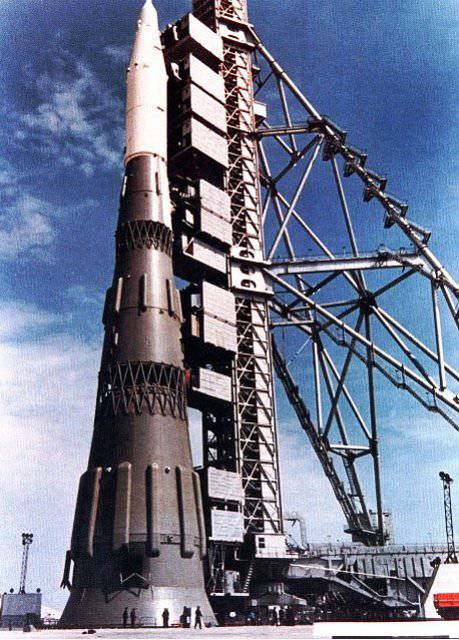
Before deciding on the final launch vehicle layout, the creators had to evaluate at least 60 of various options, from multi-block to single-block, both parallel and sequential division of a rocket into stages. For each of these options, relevant comprehensive analyzes were carried out of both advantages and disadvantages, including a feasibility study of the project.
In the course of preliminary studies, the creators were forced to abandon the multi-block scheme with parallel division into stages, although this scheme was already tested on the P-7 and made it possible to transport ready-made elements of the launch vehicle (propulsion systems, tanks) from the factory to the cosmodrome by train . The rocket was assembled and tested on site. This scheme was rejected due to a suboptimal combination of mass costs and additional hydro, mechanical, pneumatic and telecommunications between the rocket units. As a result, a monoblock scheme came to the fore, which involved the use of LRE with pre-pumps, which made it possible to reduce the wall thickness (and hence the mass) of the tanks, as well as to reduce the pressure of the pressurized gas.
The H-1 rocket project was unusual in many ways, but its main distinguishing features were the original scheme with spherical outboard tanks, as well as the carrier outer skin, which was supported by a power kit (semi-monocoque aircraft was used) and an annular arrangement of LRE at each of the stages. Thanks to this technical solution, as applied to the first stage of the rocket during the launch and its ascent, the air from the surrounding atmosphere was ejected into the inner space under the tank from the exhaust jet of the LRE. As a result, a semblance of a very large air-jet engine arose, which included the entire lower part of the 1-th stage design. Even without air afterburning of the LRE exhaust, this scheme provided the rocket with a significant increase in thrust, increasing its overall efficiency.
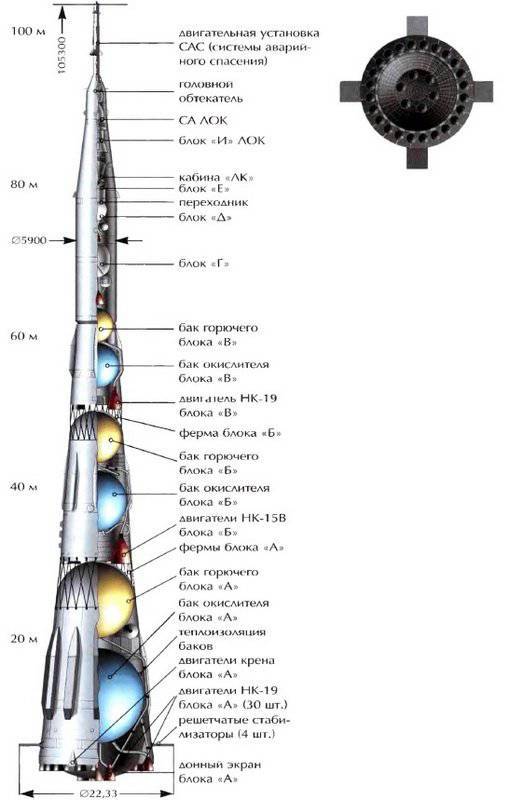
The steps of the H-1 rocket were interconnected by special transitional trusses, through which gases could freely flow out in the event of a hot start of the engines of the following steps. The rocket was controlled along the roll channel by means of control nozzles, into which the gas, discharged there after turbopump units (THA), was fed, along the pitch and course channels, the control was carried out using the misalignment of thrust of opposite LREs.
Due to the impossibility of transporting the stages of an extra-heavy rocket by rail, the creators suggested that the H-1 outer shell be made detachable, and its fuel tanks be made from sheet blanks (“petals”) directly on the cosmodrome itself. This idea initially did not fit in the head of the members of the expert committee. Therefore, having accepted the draft design of the H-1962 rocket in July 1, the commission members recommended further elaboration of the delivery of the rocket stages in assembled form, for example, with the help of a dirigible balloon.
During the defense of the draft missile draft, the 2 variant of the missile was presented to the commission: using AT as an oxidizer or liquid oxygen. In this case, the variant with liquid oxygen was considered as the main one, since a rocket would have lower characteristics when using AT-UDMH fuel. In terms of value, the creation of an engine with liquid oxygen seemed more economical. At the same time, according to representatives of OKB-1, in the event of an emergency situation on board the missile, the oxygen version seemed to be safer than the variant using an AT-based oxidant. The creators of the rocket remembered the P-16 catastrophe that occurred in October 1960 of the year and worked on the self-igniting toxic components.
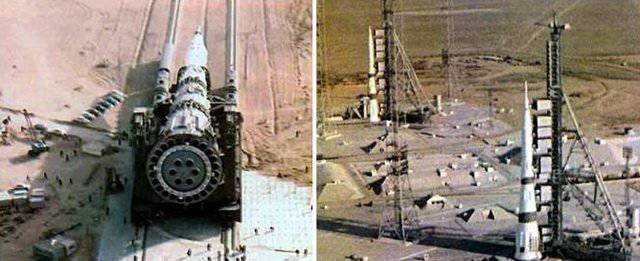
When creating the multi-engine version of the H-1 rocket, Sergei Korolev relied primarily on the concept of improving the reliability of the entire propulsion system, by possibly turning off the defective rocket engine during the flight. This principle has found its application in the engine operation control system - CORD, which was designed to detect and shut down faulty engines.
On the installation of the engine rocket engine insisted Korolev. Without the infrastructure and technological capabilities of the costly and risky creation of advanced high-energy oxygen-hydrogen engines and defending the use of more toxic and powerful heptyl-amyl engines, leading to the engine-building of the Glushko Design Bureau did not engage in engines for the ХNNXX, after which their development was entrusted to Kuznetsov Design Bureau. It should be noted that the specialists of this design bureau succeeded in achieving the highest resource and energy perfection for oxygen-kerosene-type engines. At all stages of the launch vehicle, the fuel was located in the original ball tanks, which were suspended on the carrier shell. At the same time, Kuznetsov's KB engines were not powerful enough, which led to the fact that they had to be installed in large quantities, which ultimately led to a number of negative effects.
The design kit for the H-1 was ready for March 1964, the flight test design (LCI) was scheduled to begin in the 1965 year, but this did not happen because the project was not supported by funding and resources. This was due to a lack of interest in this project - the USSR Ministry of Defense, since the payload of the rocket and the range of tasks were not specified specifically. Then Sergey Korolev tried to interest the political leadership of the state in the rocket by proposing to use the rocket in the lunar mission. This offer has been accepted. 3 August 1964, the corresponding government resolution was issued, the start date of the LCI on the rocket was shifted by 1967-1968 years.
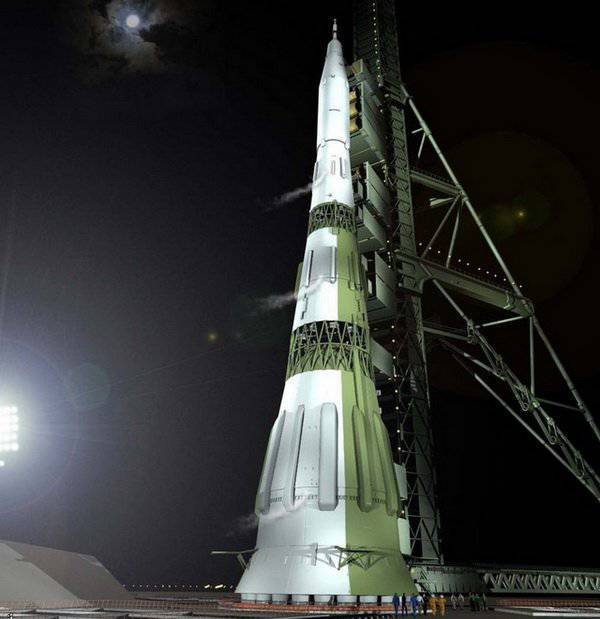
To accomplish the mission of delivering the 2 astronauts to the Moon’s orbit with the landing of one of them on the surface, it was necessary to increase the missile carrying capacity to 90-100 tons. This required solutions that would not lead to a fundamental change in the conceptual design. Such solutions were found - installing additional 6 LRE engines in the central part of the block “A”, changing the azimuth of the launch, reducing the height of the supporting orbit, increasing the fueling of the fuel tanks using fuel and oxidizer subcooling. Due to this, the load capacity of the H-1 was increased to 95 tons, and the starting weight increased to 2800-2900 tons. The outline of the H-1-LZ rocket for the lunar program was signed by the Queen 25 of December 1964.
The following year, the rocket scheme underwent changes, it was decided to abandon the ejection. The air duct was closed by the introduction of a special tail section. A distinctive feature of the rocket was the massive return on payload, which was unique to Soviet missiles. For this, the whole carrier scheme worked, in which the skeleton and the tanks did not form a single whole. At the same time, a rather small layout area due to the use of large spherical tanks led to a reduction in payload, and on the other hand, extremely high engine performance, an exceptionally low specific weight of tanks and unique design solutions increased it.
All stages of the rocket were called Blocks "A", "B", "C" (in the lunar version they were used to bring the ship to near-Earth orbit), blocks "G" and "D" were intended to disperse the ship from the Earth and braking near the Moon. The unique design of the H-1 rocket, all the stages of which were structurally similar, made it possible to transfer the test results of the 2-th stage of the rocket to the 1-th. Possible emergency situations that could not be “caught” on the ground were supposed to be checked in flight.
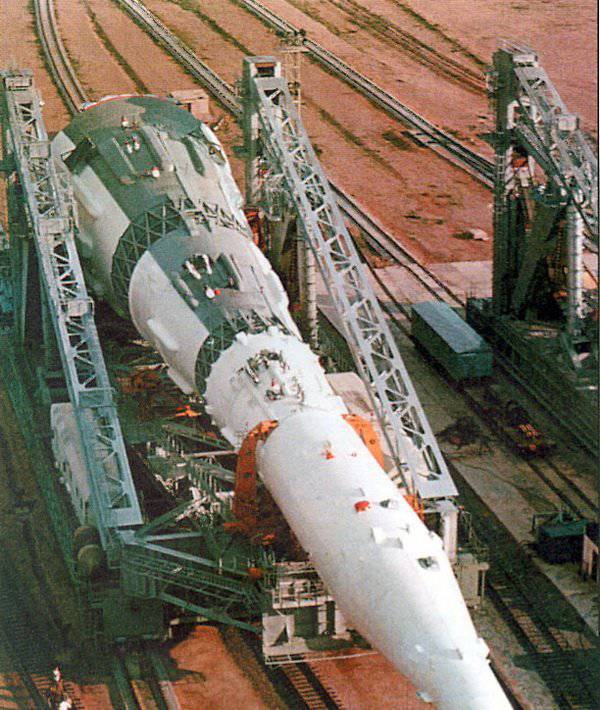
21 February 1969, the first launch of the rocket, followed by another 3 launch. All of them were unsuccessful. Although during some bench tests, the NK-33 engines proved to be very reliable, most of the problems that arose were associated with them. H-1 problems were related to the unwrapping moment, strong vibration, hydrodynamic impact (when the engines were turned on), electrical noise and other unaccounted effects caused by the simultaneous operation of such a large number of engines (30 at the first stage) .
These difficulties were impossible to establish before the start of the flight, because for the sake of saving money, expensive ground-based stands for fire and dynamic tests of the entire carrier, or at least its 1-th stage in the assembly, were not produced. The result of this was the testing of complex products directly in flight. This rather controversial approach ultimately led to a series of rocket crashes.
Some associate the failure of the project with the fact that the state from the very beginning did not have a definite clear position, like Kennedy’s strategic stake on the lunar mission. Sharkhanya Khrushchev and then Brezhnev leadership regarding effective strategies and objectives of astronautics are documented. So one of the developers of Tsar-Rocket, Sergei Kryukov, noted that the H-1 complex died not so much because of technical difficulties, but because it had become a bargaining chip in the game of personal and political ambitions.
Another veteran of the industry, Vyacheslav Galyaev, believes that the determining factor of failures, in addition to the lack of due attention from the state, was the banal inability to work with such complex objects, while achieving the approval of quality and reliability criteria, and the lack of readiness of Soviet science at that time implementation of such a large-scale program. Anyway, in June 1974, the work on the Н1-LZ complex was stopped. The reserve available for this program was destroyed, and the costs (in the amount of 4-6 billion rubles in 1970 prices of the year) were simply written off.
Information sources:
-http: //ria.ru/analytics/20090220/162721270.html
-http: //www.buran.ru/htm/gud%2019.htm
-http: //www.astronaut.ru/bookcase/article/article04.htm? reload_coolmenus
-http: //ru.wikipedia.org/wiki/%CD-1#cite_note-3
Information